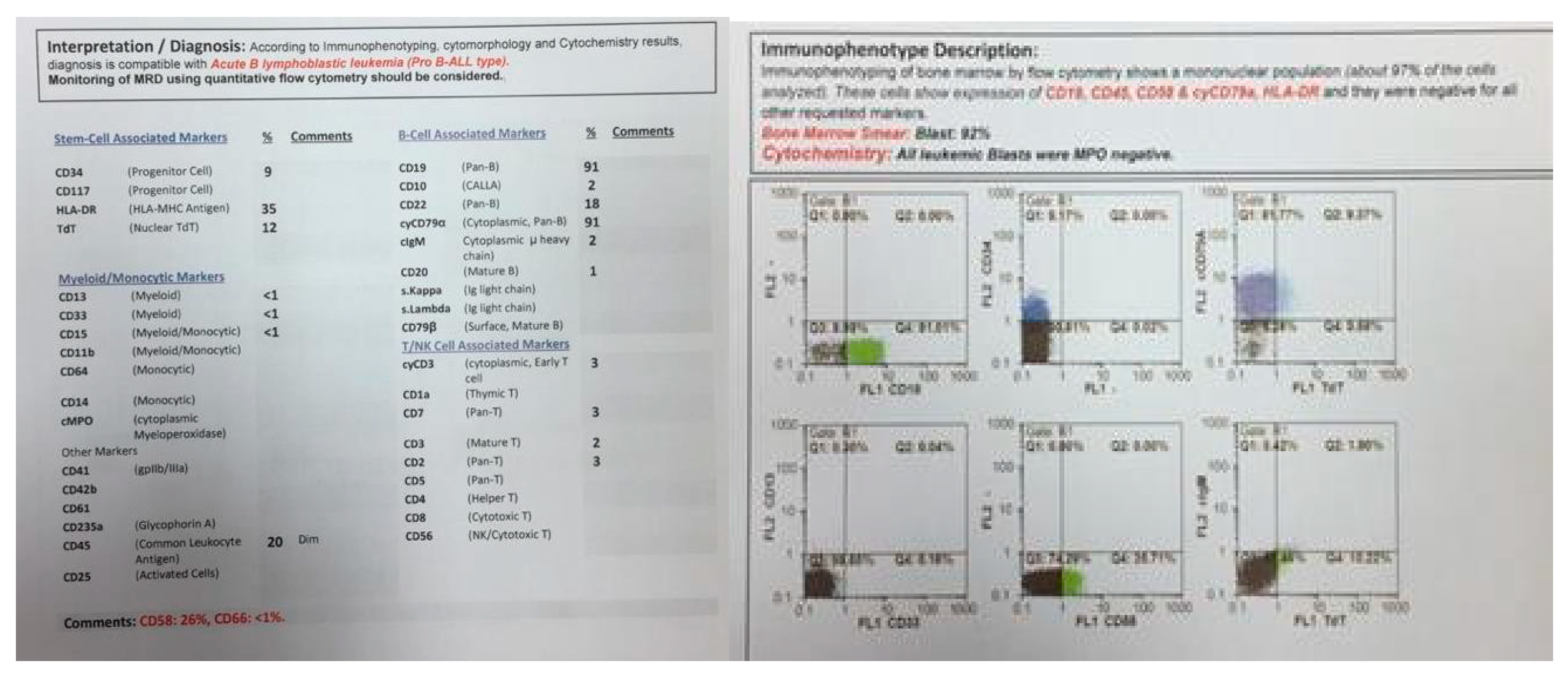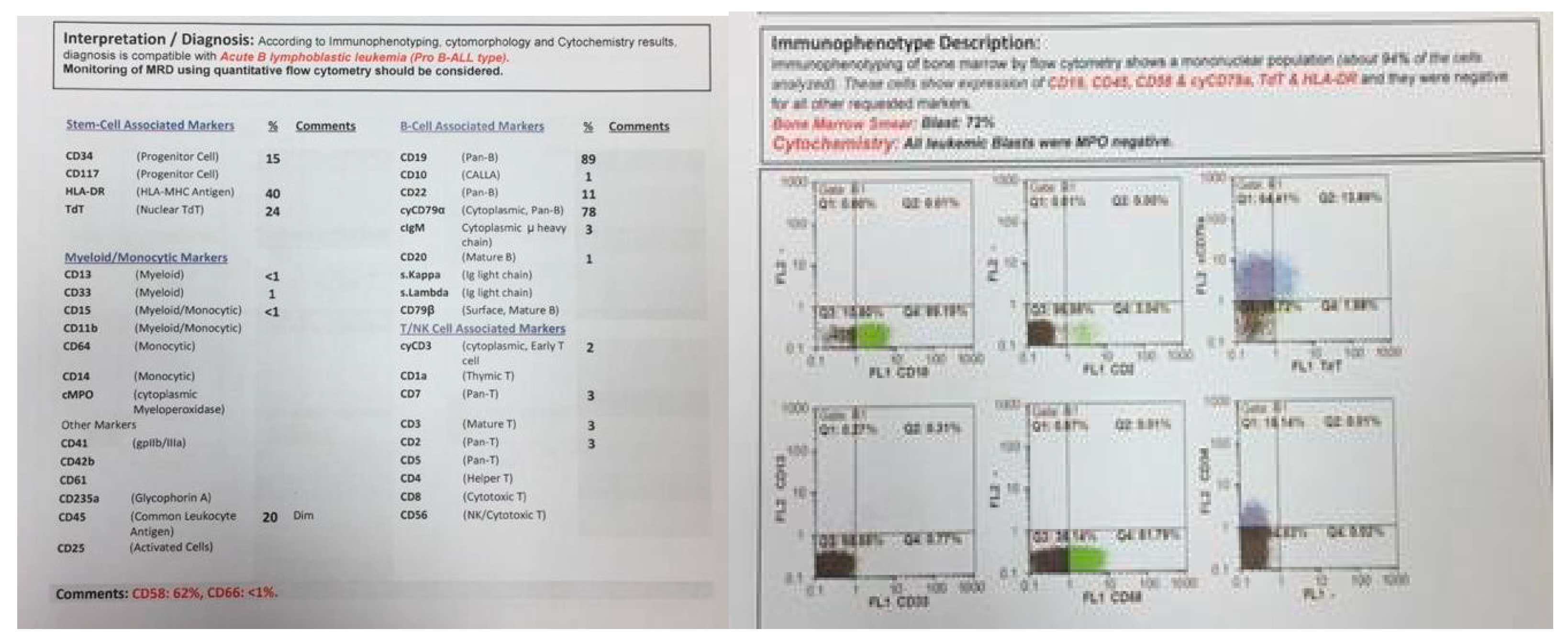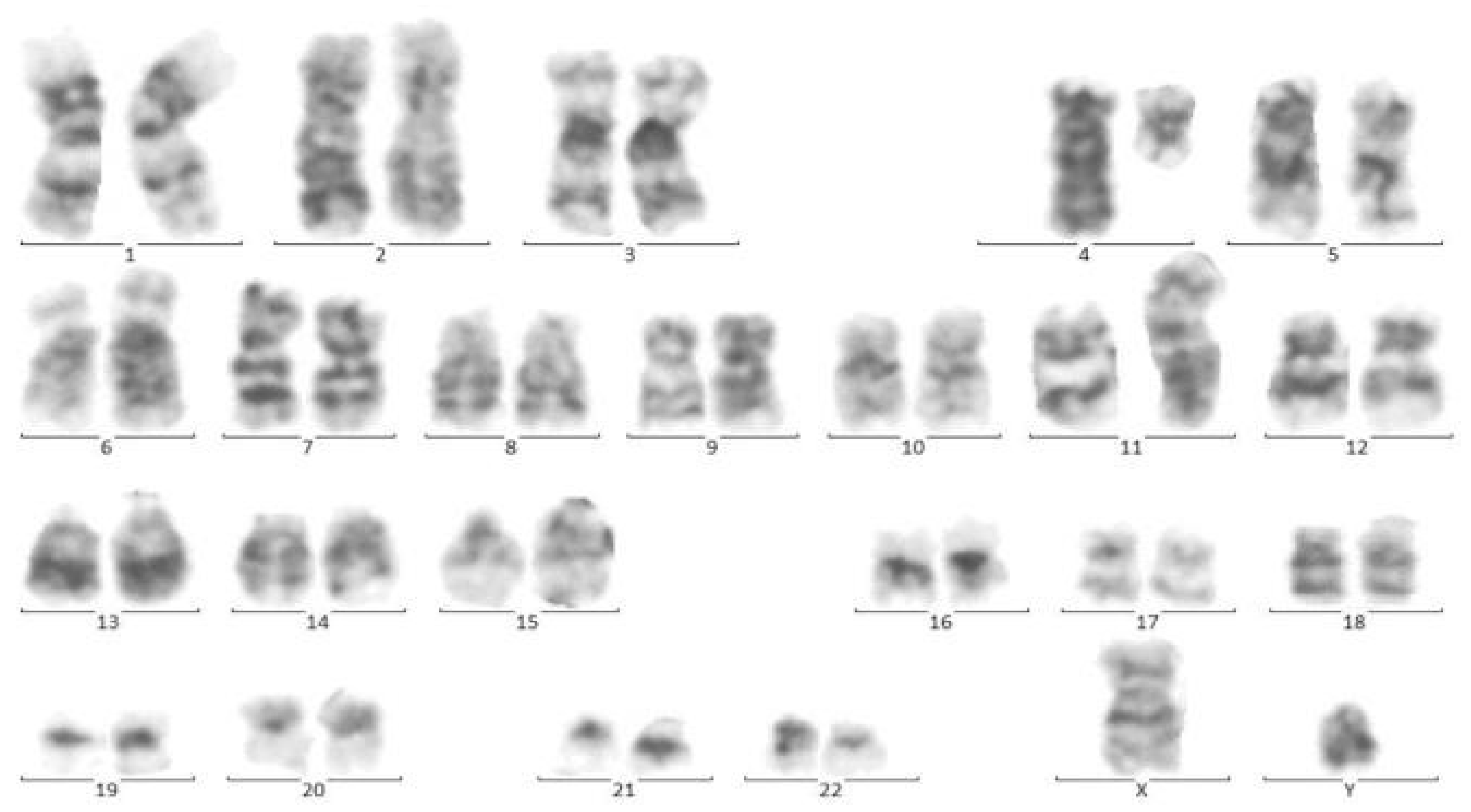Detection of New Translocation in Infant Twins with Concordant ALL and Discordant Outcome
Abstract
1. Introduction
2. Case Presentation
3. Discussion
Funding
Institutional Review Board Statement
Informed Consent Statement
Data Availability Statement
Conflicts of Interest
References
- Lanzkowsky, P.; Lipton, J.M.; Fish, J.D. Lanzkowsky’s Manual of Pediatric Hematology and Oncology, 6th ed.; Academic Press: London, UK, 2016. [Google Scholar]
- Bahoush-Mehdiabadi, G.; Habibi, R.; Shariftabrizi, A.; Vossough, P. Epidemiologic Survey of Infantile Cancer in Iran based on the Data of the Largest Pediatric Cancer Referral Center (Ali-Asghar Children Hospital), 1996–2005. Asian Pac. J. Cancer Prev. 2014, 15, 1211–1217. [Google Scholar] [CrossRef] [PubMed][Green Version]
- Pieters, R.; Schrappe, M.; De Lorenzo, P.; Hann, I.; De Rossi, G.; Felice, M.; Hovi, L.; Leblanc, T.; Szczepanski, T.; Ferster, A.; et al. A treatment protocol for infants younger than 1 year with acute lymphoblastic leukaemia (Interfant-99): An observational study and a multicentre randomised trial. Lancet 2007, 370, 240–250. [Google Scholar] [CrossRef]
- Pieters, R.; De Lorenzo, P.; Ancliffe, P.; Aversa, L.A.; Brethon, B.; Biondi, A.; Campbell, M.; Escherich, G.; Ferster, A.; Gardner, R.A.; et al. Outcome of Infants Younger Than 1 Year With Acute Lymphoblastic Leukemia Treated With the Interfant-06 Protocol: Results From an International Phase III Randomized Study. J. Clin. Oncol. 2019, 37, 2246–2256. [Google Scholar] [CrossRef] [PubMed]
- Gale, K.B.; Ford, A.M.; Repp, R.; Borkhardt, A.; Keller, C.; Eden, O.B.; Greaves, M. Backtracking leukemia to birth: Identification of clonotypic gene fusion sequences in neonatal blood spots. Proc. Natl. Acad. Sci. USA 1997, 94, 13950–13954. [Google Scholar] [CrossRef] [PubMed]
- Valentine, M.C.; Linabery, A.M.; Chasnoff, S.; Hughes, A.E.O.; Mallaney, C.; Sanchez, N.; Giacalone, J.; A Heerema, N.; Hilden, J.M.; Spector, L.G.; et al. Excess congenital non-synonymous variation in leukemia-associated genes in MLL− infant leukemia: A Children’s Oncology Group report. Leukemia 2013, 28, 1235–1241. [Google Scholar] [CrossRef] [PubMed]
- Ross, J.A.; Linabery, A.M.; Blommer, C.N.; Langer, E.K.; Spector, L.G.; Hilden, J.M.; Heerema, N.A.; Radloff, G.A.; Tower, R.L.; Davies, S.M. Genetic variants modify susceptibility to leukemia in infants: A Children’s Oncology Group report. Pediatr Blood Cancer 2013, 60, 31–34. [Google Scholar] [CrossRef]
- Nagayama, J.; Tomizawa, D.; Koh, K.; Nagatoshi, Y.; Hotta, N.; Kishimoto, T.; Takahashi, Y.; Kuno, T.; Sugita, K.; Sato, T.; et al. Infants with acute lymphoblastic leukemia and a germline MLL gene are highly curable with use of chemotherapy alone: Results from the Japan Infant Leukemia Study Group. Blood 2006, 107, 4663–4665. [Google Scholar] [CrossRef]
- Ford, A.M.; Ridge, S.A.; Cabrera, M.E.; Mahmoud, H.; Steel, C.M.; Chan, L.C.; Greaves, M. In utero rearrangements in the trithorax-related oncogene in infant leukaemias. Nat. Cell Biol. 1993, 363, 358–360. [Google Scholar] [CrossRef]
- Maia, A.-T.; Ford, A.M.; Jalali, G.R.; Harrison, C.J.; Taylor, G.M.; Eden, O.B.; Greaves, M. Molecular tracking of leukemogenesis in a triplet pregnancy. Blood 2001, 98, 478–482. [Google Scholar] [CrossRef]
- Megonigal, M.D.; Rappaport, E.F.; Jones, D.H.; Williams, T.M.; Lovett, B.D.; Kelly, K.M.; Lerou, P.H.; Moulton, T.; Budarf, M.L.; Felix, C.A. t(11;22)(q23;q11.2) in acute myeloid leukemia of infant twins fuses MLL with hCDCrel, a cell division cycle gene in the genomic region of deletion in DiGeorge and velocardiofacial syndromes. Proc. Natl. Acad. Sci. USA 1998, 95, 6413–6418. [Google Scholar] [CrossRef]
- Li, X.; Sun, N.; Huang, X. Two Pairs of Monozygotic Twins with Concordant Acute Lymphoblastic Leukemia (ALL): Case Report. J. Pediatr. Hematol. Oncol. 2014, 36, e299–e303. [Google Scholar] [CrossRef] [PubMed][Green Version]
- Senator, H. Zur Kenntniss der leukamie und pseudoleukaemie im kindesalter. Berl. Klin. Wochenschr. 1882, 35, 533–536. [Google Scholar]
- Wolman, I.J. Parallel responses to chemotherapy in identical twin infants with concordant leukemia. J. Pediatr. 1962, 60, 91–96. [Google Scholar] [CrossRef]
- Clarkson, B.; Boyse, E.A. Possible explanation of the high concordance for acute leukaemia in monozygotic twins. Lancet 1971, 1, 699–701. [Google Scholar] [CrossRef]
- MacMahon, B.; Levy, M.A. Prenatal origin of childhood leukemia. N. Engl. J. Med. 1964, 270, 1082–1085. [Google Scholar] [CrossRef]
- Domer, P.H.; Fakharzadeh, S.S.; Chen, C.S.; Jockel, J.; Johansen, L.; Silverman, G.A.; Kersey, J.H.; Korsmeyer, S.J. Acute mixed-lineage leukemia t(4;11)(q21;q23) generates an MLL-AF4 fusion product. Proc. Natl. Acad. Sci. USA 1993, 90, 7884–7888. [Google Scholar] [CrossRef]
- Gu, Y.; Nakamura, T.; Alder, H.; Prasad, R.; Canaani, O.; Cimino, G.; Croce, C. The t(4;11) chromosome translocation of human acute leukemias fuses the ALL-1 gene, related to Drosophila trithorax, to the AF-4 gene. Cell 1992, 71, 701–708. [Google Scholar] [CrossRef]
- Rubnitz, J.E.; Link, M.P.; Shuster, J.J.; Carroll, A.J.; Hakami, N.; Frankel, L.S.; Pullen, D.J.; Cleary, M.L. Frequency and prognostic significance of HRX rearrangements in infant acute lymphoblastic leukemia: A Pediatric Oncology Group study. Blood 1994, 84, 570–573. [Google Scholar] [CrossRef]
- Greaves, M.F.; Maia, A.T.; Wiemels, J.L.; Ford, A.M. Leukemia in twins: Lessons in natural history. Blood 2003, 102, 2321–2333. [Google Scholar] [CrossRef]
- Campbell, M.; Cabrera, M.E.; Legues, M.E.; Ridge, S.; Greaves, M. Discordant clinical presentation and outcome in infant twins sharing a common clonal leukaemia. Br. J. Haematol. 1996, 93, 166–169. [Google Scholar] [CrossRef]
- Broadfield, Z.J.; Hain, R.D.W.; Harrison, C.J.; Jalali, G.R.; McKinley, M.; Michalová, K.; Robinson, H.M.; Zemanová, Z.; Martineau, M. Complex chromosomal abnormalities in utero, 5 years before leukaemia. Br. J. Haematol. 2004, 126, 307–312. [Google Scholar] [CrossRef] [PubMed]
- Stumpel, D.J.P.M.; Schneider, P.; Van Roon, E.H.J.; Boer, J.M.; De Lorenzo, P.; Valsecchi, M.G.; De Menezes, R.X.; Pieters, R.; Stam, R. (Ronald) Specific promoter methylation identifies different subgroups of MLL-rearranged infant acute lymphoblastic leukemia, influences clinical outcome, and provides therapeutic options. Blood 2009, 114, 5490–5498. [Google Scholar] [CrossRef] [PubMed]
- Robinson, B.W.; Behling, K.C.; Gupta, M.; Zhang, A.Y.; Moore, J.S.; Bantly, A.D.; Willman, C.L.; Carroll, A.J.; Adamson, P.C.; Barrett, J.S.; et al. Abundant anti-apoptotic BCL-2 is a molecular target in leukaemias with t(4;11) translocation. Br. J. Haematol. 2008, 141, 827–839. [Google Scholar] [CrossRef] [PubMed]
- Tulstrup, M.; Stoltze, U.K.; Schmiegelow, K.; Yangp, J.J. Epidemiology and Etiology of Childhood ALL. Child. Acute Lymphoblastic Leuk. 2017, 10, 1–27. [Google Scholar]
- Fedders, H.; Alsadeq, A.; Petersen, B.-S.; Kellner, C.; Peipp, M.; Valerius, T.; Haesler, R.; Alten, J.; Möricke, A.; Strube, S.; et al. Analyses of a Pair of Concordant Twins with Infant ALL and Discordant Clinical Outcome Reveals Immunoescape As a Mechanism of Disease Persistence in MLL-Rearranged Leukemia. Blood 2014, 124, 3791. [Google Scholar] [CrossRef]
- Fedders, H.; Petersen, B.; Alsadeq, A.; Kellner, C.; Peipp, M.; Bulduk, M.; Valerius, T.; Häsler, R.; Alten, J.; Möricke, A.; et al. A Case of Concordant Twins with Infant ALL and Discordant Clinical Outcome–Part I: The genetic basis–identification of DSC2 as a gene with prognostic impact in infant MLL-rearranged ALL. Klin. Pädiatrie 2015, 227, A16. [Google Scholar] [CrossRef]




Publisher’s Note: MDPI stays neutral with regard to jurisdictional claims in published maps and institutional affiliations. |
© 2020 by the authors. Licensee MDPI, Basel, Switzerland. This article is an open access article distributed under the terms and conditions of the Creative Commons Attribution (CC BY) license (http://creativecommons.org/licenses/by/4.0/).
Share and Cite
Bahoush, G.; Vafapour, M.; Kariminejad, R. Detection of New Translocation in Infant Twins with Concordant ALL and Discordant Outcome. Pediatr. Rep. 2021, 13, 9-14. https://doi.org/10.3390/pediatric13010002
Bahoush G, Vafapour M, Kariminejad R. Detection of New Translocation in Infant Twins with Concordant ALL and Discordant Outcome. Pediatric Reports. 2021; 13(1):9-14. https://doi.org/10.3390/pediatric13010002
Chicago/Turabian StyleBahoush, Golamreza, Maryam Vafapour, and Roxana Kariminejad. 2021. "Detection of New Translocation in Infant Twins with Concordant ALL and Discordant Outcome" Pediatric Reports 13, no. 1: 9-14. https://doi.org/10.3390/pediatric13010002
APA StyleBahoush, G., Vafapour, M., & Kariminejad, R. (2021). Detection of New Translocation in Infant Twins with Concordant ALL and Discordant Outcome. Pediatric Reports, 13(1), 9-14. https://doi.org/10.3390/pediatric13010002




